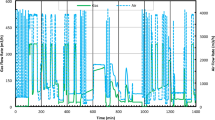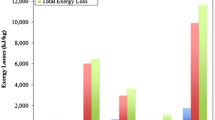Abstract
This research investigated optimal energy utilization with pinch technology based on an actual gelatin production factory using a three-effect evaporator (TEE). A TEE is a well-known device used extensively when concentrating process fluid with large amounts of boiler steam. Under ideal energy use conditions, the exhaust heat can be recovered with the addition of a heat pump system. The study results showed that the original energy demand and discharge of the TEE were 1,736.2 and 1,733.2 kWh, respectively. Simulating the pinch technology use, the energy demand and discharge decreased to 1,531.5 and 1,527.7 kWh, respectively. When the heat pump was used to recover the exhaust heat, 324 kL per annum of fuel oil was saved, while electricity use increased 131 kWh. The total investment cost was 86,550 US$, but the total annual operation cost could save up to 166,421 US$. The net present value was estimated to be 544,316 US$ with a 5-year equipment operation. The investment expense could be completely recovered within a seven-month remuneration period.
Similar content being viewed by others
References
A. E. Niesnfeld, Industrial evaporators, Instrument Society of America (1985).
B. Linnhoff, D.W. Townsend, D. Boland, G. F. Hewitt, B. E. A. Thomas, A. R. Guy and R. H. Marsland, User guide on process integration for the efficient use of energy, 1st Ed., Institution of Chem. Eng., Rugby, UK (1982).
B. Linnhoff and E. Hindmarsh, Chem. Eng. Sci., 38, 745 (1983).
B. Linnhoff and S. Ahmad, Comp. Chem. Eng., 147, 729 (1990).
S. Ahmad, B. Linnhoff and R. Smith, Comp. Chem. Eng., 14, 751 (1990).
H. P. Lee, I.Y. Lee and K. O. Yoo, Korean J. Chem. Eng., 12, 589 (1995).
T. N. Tjoe and B. Linnhoff, Chem. Eng., 28, 47 (1986).
N. D. K. Asante and X.Y. Zhu, Comp. Chem. Eng., 20, S7 (1996).
M.A. Phipps and A. F. A. Hoadley, Korean J. Chem. Eng., 20, 642 (2003).
A. I. A. Salama, Appl. Therm. Eng., 29, 2633 (2009).
T. Gundersen and L. Naess, Heat Recovery Systems & CHP, 10, 301 (1990).
F. Staine and D. Favrat, Appl. Therm. Eng., 16, 497 (1996).
R.M. Lazzarin, Heat Recovery System & CHP, 14, 581 (1994).
R.M. Lazzarin, Heat Recovery System & CHP, 15, 305 (1995).
Langley and C. Billy, Heat pump technology, 1st Ed., Prentice Hall, New Jersey, USA (2001).
I.C. Kemp, Pinch analysis and process integration, 2nd Ed., Elsevier Ltd, UK (2007).
T. D. Eastop and D. R. Croft, Energy efficiency, 1st Ed., Longman Group Ltd., Malaysia, KPP (1995).
Z. Fonyo and N. Benko, Comp. Chem. Eng., 20, S85 (1996).
C. Wu, L. Chen and F. Sun, Energy Convers. Manage., 39, 445 (1998).
J. M. Smith, H.C. Van Ness and M.M. Abbott, Introduction to chemical engineering thermodynamics, 7th Ed., McGraw-Hill, New York (2005).
A. Nguyen, Y. Kim and Y. Shin, Int. J. Refriger., 28, 242 (2005).
K. J. Park, Y. Lee and D. Jung, J. Mechanical Sci. Technol., 24, 879 (2010).
IEA, Heat Pump Centre, Heat pump performance, International Energy Agency (IEA) Heat Pump Centre, retrieved November 22, 2010 from: 〈http://www.heatpumpcentre.org〉.
W. F. Stoecker and J.W. Jones, Refrigeration and air conditioning, 2nd Ed., McGraw-Hill, Taipei, Taiwan (1982).
C.M. Tan, Metal extraction in refrigerant R134a, Master’s Thesis, National Chiao Tung University, Hsinchu, Taiwan (2002).
M.Y. Lee, D.W. Choi and Y. H. Kim, Korean J. Chem. Eng., 26, 631 (2009).
C. K. Yoo, T.Y. Lee, J. Kim, I. Moon, J. H. Jung, C. Han, J.M. Oh and I. B. Lee, Korean J. Chem. Eng., 24, 567 (2007).
Author information
Authors and Affiliations
Corresponding author
Rights and permissions
About this article
Cite this article
Tuan, CI., Yeh, YL., Hsu, LF. et al. The pinch technology combined with a heat pump applied in a three-effect evaporator and energy-saving performance assessment. Korean J. Chem. Eng. 29, 341–348 (2012). https://doi.org/10.1007/s11814-011-0173-7
Received:
Accepted:
Published:
Issue Date:
DOI: https://doi.org/10.1007/s11814-011-0173-7




